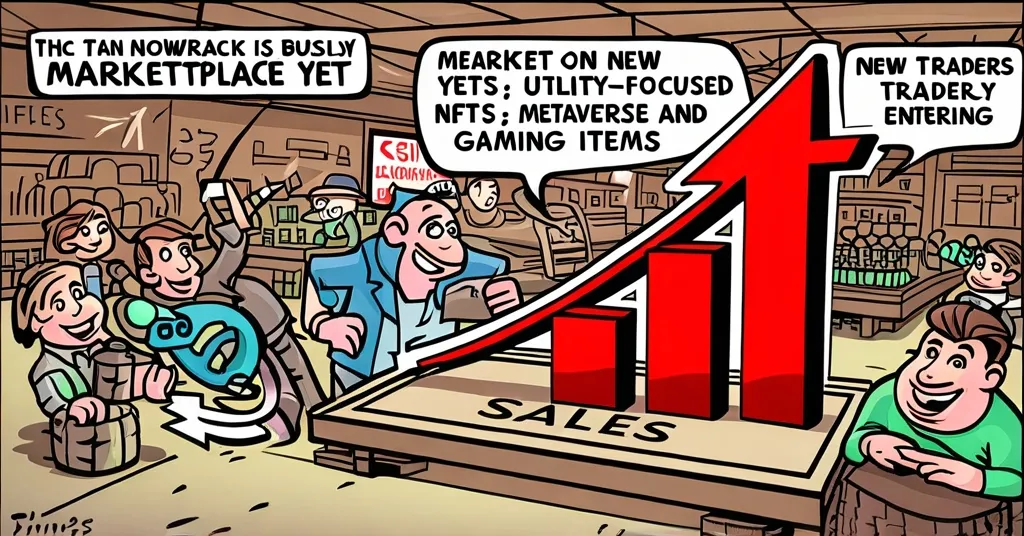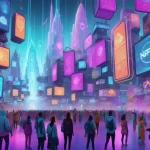NFT Market Sees 35% Sales Drop Yet New Traders Surge: A Shift to Utility-Focused NFTs

NFT Market Dives as Sales Plummet, Yet New Traders Surge In
The NFT market is experiencing a significant downturn, with sales dropping to $112.7 million, marking a 35.15% decline from the previous week. Amidst this decline, however, there’s a notable surge in new traders, suggesting a growing interest in digital assets.
- NFT market downturn
- Surge in new traders
- Leading blockchain platforms
- Shift to utility-focused NFTs
Despite the chill in the market, Ethereum, the primary platform for NFTs, saw a 41.25% drop in sales to $56.0 million. Yet, the number of buyers on Ethereum increased by 81.43% to 30,598, indicating that while the market cools, the curiosity of new traders heats up. This dichotomy paints a picture of a market in transition, where the allure of blockchain’s promise still captivates despite the bearish trends.
Other platforms showed mixed signals: Mythos Chain saw a modest increase of 4.66% to $13.9 million, while Solana took a hit with a 32.56% decrease to $11 million. Polygon managed to grow its sales by 10.76% to $8.1 million, showing resilience in the face of market volatility. Bitcoin NFTs, often overlooked in the NFT frenzy, saw a dramatic 71.42% decline to $6.7 million, perhaps a sign that the hype surrounding them has waned.
In this shifting landscape, collections like DMarket and Courtyard have emerged as leaders, with sales of $8.7 million and $7.3 million respectively. CryptoPunks and Pudgy Penguins, once the darlings of the NFT world, managed $5.2 million and $5.1 million in sales, respectively, while Azuki trailed at $5 million, signaling a potential cooling in what was once a red-hot market.
Yet, amidst the gloom, there’s a silver lining: the market is pivoting towards NFTs with tangible utility, particularly those entwined with the metaverse and gaming ecosystems. The metaverse refers to a virtual reality space where users can interact with a computer-generated environment and other users. This shift indicates a maturing market, one that values function over mere speculation. As the dust settles, it’s clear that the days of buying JPEGs simply for their rarity might be numbered, making way for NFTs that enhance virtual experiences and offer more than just a digital brag.
The surge in new participants, despite the declining sales, reflects a growing curiosity in blockchain technology and its potential to revolutionize digital ownership. These newcomers, undeterred by the chilly market, may be the harbingers of a new era where quality and utility reign supreme. But let’s not kid ourselves—the road ahead is fraught with challenges, including regulatory hurdles and the ever-present risk of scams and rug pulls. Rug pulls are fraudulent schemes where developers abandon a project and run away with investors’ money.
While the NFT market continues its downward trend even as crypto prices stabilize, this downturn is not without its silver linings. The notable surge in participation, particularly among new traders, suggests an undying interest in the potential of blockchain and digital assets. This interest, even in the face of declining values, shows the resilience of the crypto community and the promise of decentralization.
However, let’s be real: the hype that once fueled the NFT market boom was partly driven by celebrities like Donald Trump, whose digital trading cards sold out in minutes. This kind of hype can lead to market saturation and a subsequent decline as investors grow wary of speculative investments. The shift towards utility-focused NFTs is a welcome change, but it’s crucial to remain cautious. Not every NFT project will deliver on its promises, and the risk of scams remains high.
Despite these challenges, the potential for NFTs to revolutionize gaming and the metaverse is undeniable. Imagine buying an NFT that not only lets you own a piece of digital art but also grants you access to exclusive virtual events or in-game advantages. This is where the future of NFTs lies—not in get-rich-quick schemes, but in building a new digital economy that leverages the power of blockchain.
The recent positive regulatory clarity from the SEC regarding Ethereum 2.0 could boost market sentiment and potentially enhance the value of Ethereum-based NFTs in the long term. This development underscores the importance of regulatory support in fostering a healthy ecosystem for digital assets.
As we navigate these waters, it’s crucial to stay grounded in the realities of the market. While the promise of decentralization and freedom through NFTs is alluring, the path to widespread adoption and genuine utility will require more than just hype and celebrity endorsements. It’s about building ecosystems that truly leverage the power of blockchain, and in that, the future of NFTs might just be brighter than we think.
“The NFT market continues its downward trend even as crypto prices stabilize.”
“Despite lower overall values, the market has seen a notable surge in participation, suggesting growing interest from new traders.”
“There is growing interest in NFTs with real utility, particularly those tied to the metaverse and gaming ecosystems, suggesting the market is shifting towards more functional assets rather than speculative collectibles.”
Key Takeaways and Questions
- What’s happening with NFT sales?
The NFT market is in a downturn, with sales volume at $112.7 million, down 35.15% from the previous week.
- How are new traders impacting the market?
New traders are entering the market in droves, with buyer numbers surging by 81.43%, indicating growing interest despite lower sales volumes.
- Which blockchain platforms are at the forefront of NFT sales?
Ethereum leads despite a 41.25% drop in sales, followed by Mythos Chain, Solana, and Polygon, each showing varied performance.
- What NFT collections are leading the market?
DMarket and Courtyard lead with $8.7 million and $7.3 million in sales, while CryptoPunks and Pudgy Penguins trail with $5.2 million and $5.1 million respectively.
- What trends are we seeing in the NFT market?
There’s a shift towards NFTs integrated with the metaverse and gaming, highlighting a focus on utility over speculation.
- How has the hype-driven boom affected the NFT market?
The initial hype led to market saturation and a decline in sales as investors grew wary of speculative investments.



